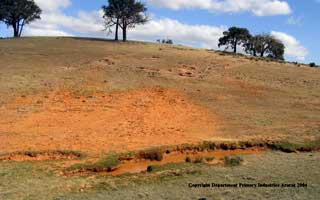Tunnel erosion
|
What is it? |  Tunnel erosion in a sloping agricultural landscape producing red-brown sediment fans at the outlets of the tunnels |
Impact
Tunnel erosion disrupts soil continuity, increases soil drainage, reduces water holding capacity and considerably reduces productivity. Material scoured from the tunnels is relatively inhospitable to biological activity and thus areas of deposition also reduce plant growth and productivity. Clay transported from the tunnels is highly mobile and can readily reach streams and reservoirs.
Management
A key part of the management of tunnel prone areas is to maximise vegetative cover. It is also useful to modify clay dispersion in the profile, perhaps requiring the use of gypsum. Further information on this and the reclamation of areas already eroded is available at the reclamation of tunnelled land page.
Related Links
See the distribution of tunnel erosion page for information on tunnel erosion in Victoria
See the case studies page for further information
The references page lists a selection of pertinent documents


